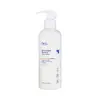What's inside
What's inside
 Key Ingredients
Key Ingredients

No key ingredients
 Benefits
Benefits

 Concerns
Concerns

 Ingredients Side-by-side
Ingredients Side-by-side

Water
Skin ConditioningPropanediol
SolventHydrogenated Polydecene
EmollientSqualane
EmollientPolyglyceryl-3 Distearate
EmulsifyingGlycerin
HumectantVinyldimethicone
Silica
AbrasiveSorbitan Stearate
Emulsifying1,2-Hexanediol
Skin ConditioningCetearyl Olivate
Ceramide NP
Skin ConditioningCaprylyl Glycol
EmollientSorbitan Olivate
EmulsifyingOlea Europaea Oil Unsaponifiables
Skin ConditioningHydrogenated Lecithin
EmulsifyingGlyceryl Stearate Citrate
EmollientPolyacrylate Crosspolymer-6
Emulsion StabilisingGlyceryl Glucoside
HumectantXanthan Gum
EmulsifyingGlycine Soja Oil Unsaponifiables
EmollientTriticum Vulgare Germ Oil Unsaponifiables
EmollientTocopherol
AntioxidantIsomalt
HumectantSucrose Cocoate
EmulsifyingCholesterol
EmollientGluconolactone
Skin ConditioningEthylhexylglycerin
Skin ConditioningPalmitic Acid
EmollientCaprylic/Capric Triglyceride
MaskingPollen Extract
EmollientDisodium EDTA
Sodium Hyaluronate
HumectantXylitylglucoside
HumectantAnhydroxylitol
HumectantT-Butyl Alcohol
PerfumingPolyglyceryl-10 Stearate
Skin ConditioningPolyglyceryl-10 Oleate
Skin ConditioningXylitol
HumectantGlucose
HumectantAluminum/Magnesium Hydroxide Stearate
Emulsion StabilisingMyristic Acid
CleansingTremella Fuciformis Polysaccharide
Emulsion StabilisingSodium Stearoyl Glutamate
CleansingStearic Acid
Cleansing7-Dehydrocholesterol
Emulsion StabilisingSodium Ascorbyl Phosphate
AntioxidantCalcium Chloride
AstringentVitis Vinifera Juice Extract
AntioxidantPhytol
EmollientWater, Propanediol, Hydrogenated Polydecene, Squalane, Polyglyceryl-3 Distearate, Glycerin, Vinyldimethicone, Silica, Sorbitan Stearate, 1,2-Hexanediol, Cetearyl Olivate, Ceramide NP, Caprylyl Glycol, Sorbitan Olivate, Olea Europaea Oil Unsaponifiables, Hydrogenated Lecithin, Glyceryl Stearate Citrate, Polyacrylate Crosspolymer-6, Glyceryl Glucoside, Xanthan Gum, Glycine Soja Oil Unsaponifiables, Triticum Vulgare Germ Oil Unsaponifiables, Tocopherol, Isomalt, Sucrose Cocoate, Cholesterol, Gluconolactone, Ethylhexylglycerin, Palmitic Acid, Caprylic/Capric Triglyceride, Pollen Extract, Disodium EDTA, Sodium Hyaluronate, Xylitylglucoside, Anhydroxylitol, T-Butyl Alcohol, Polyglyceryl-10 Stearate, Polyglyceryl-10 Oleate, Xylitol, Glucose, Aluminum/Magnesium Hydroxide Stearate, Myristic Acid, Tremella Fuciformis Polysaccharide, Sodium Stearoyl Glutamate, Stearic Acid, 7-Dehydrocholesterol, Sodium Ascorbyl Phosphate, Calcium Chloride, Vitis Vinifera Juice Extract, Phytol
 Reviews
Reviews

Ingredients Explained
These ingredients are found in both products.
Ingredients higher up in an ingredient list are typically present in a larger amount.
Glycerin is already naturally found in your skin. It helps moisturize and protect your skin.
A study from 2016 found glycerin to be more effective as a humectant than AHAs and hyaluronic acid.
As a humectant, it helps the skin stay hydrated by pulling moisture to your skin. The low molecular weight of glycerin allows it to pull moisture into the deeper layers of your skin.
Hydrated skin improves your skin barrier; Your skin barrier helps protect against irritants and bacteria.
Glycerin has also been found to have antimicrobial and antiviral properties. Due to these properties, glycerin is often used in wound and burn treatments.
In cosmetics, glycerin is usually derived from plants such as soybean or palm. However, it can also be sourced from animals, such as tallow or animal fat.
This ingredient is organic, colorless, odorless, and non-toxic.
Glycerin is the name for this ingredient in American English. British English uses Glycerol/Glycerine.
Learn more about GlycerinSqualane is an emollient that helps the skin hold onto moisture. It's an oily liquid that occurs naturally in certain types of fish and plant oils.
Because squalane boosts hydration in the skin, it also comes with plenty of benefits: it is an antioxidant and can help fight free radicals and skin damage. Squalane is also found to have a detoxifying effect when applied.
Squalane comes from squalene, which occurs naturally within the sebum of our skin. It is one of the oils our skin produces to keep itself hydrated. Squalane is the hydrogenated version of squalene and has a longer shelf life.
Research shows that squalane is non-irritating (even at 100% concentration).
In general, it's a fantastic ingredient. It does a great job at hydrating the skin, and it's suitable for those with sensitive skin.
The source of squalane may impact malassezia / fungal acne. This is because olive oil derived squalane can contain impurities such as fatty acids and plant waxes. Sugarcane derived squalane is recommended for anyone with malassezia concerns.
Is squalane vegan?
This depends on the source. Squalane can be derived from both plants and animals. Most squalane used in skincare comes from plants.
Please note: the source of squalane is only known if disclosed by the brand. We recommend reaching out to the brand if you have any questions about their squalane.
Read more about squalene with an "e".
Is squalane an oil?
Squalane is often called an oil, but it’s technically not; it’s a hydrocarbon, meaning it’s only made of carbon and hydrogen, unlike true oils which are triglycerides made of fatty acids and glycerol.
The term “oil-free” isn’t regulated, so companies can define it however they want. Some exclude all oils, while others just avoid mineral oil or comedogenic oils.
While some people avoid oils thinking they cause breakouts, the right kind of oil (or oil-like ingredient like squalane) can actually help balance and hydrate your skin. It’s worth testing out simple oils or squalane to see what works best for your skin.
Learn more about SqualaneStearic Acid is a fatty acid. It is an emollient, emulsifier, and texture enhancer.
As an emollient, stearic acid helps soften skin. It aids the skin's protective barrier by preventing water loss. It also provides a gentle cleansing effect without stripping away natural oils.
Stearic acid may also be used to enhance the texture of products. It can add volume and stabilize ingredients such as water and oil. This can help water and oil ingredients from separating.
Sources of stearic acid include animal or vegetable fats/oils such as coconut or shea. It can be naturally found in butter, cocoa butter, shea butter, vegetable fats, and animal tallow.
This ingredient may not be Malassezia folliculitis, or fungal-acne safe.
Learn more about Stearic AcidWater. It's the most common cosmetic ingredient of all. You'll usually see it at the top of ingredient lists, meaning that it makes up the largest part of the product.
So why is it so popular? Water most often acts as a solvent - this means that it helps dissolve other ingredients into the formulation.
You'll also recognize water as that liquid we all need to stay alive. If you see this, drink a glass of water. Stay hydrated!
Learn more about Water